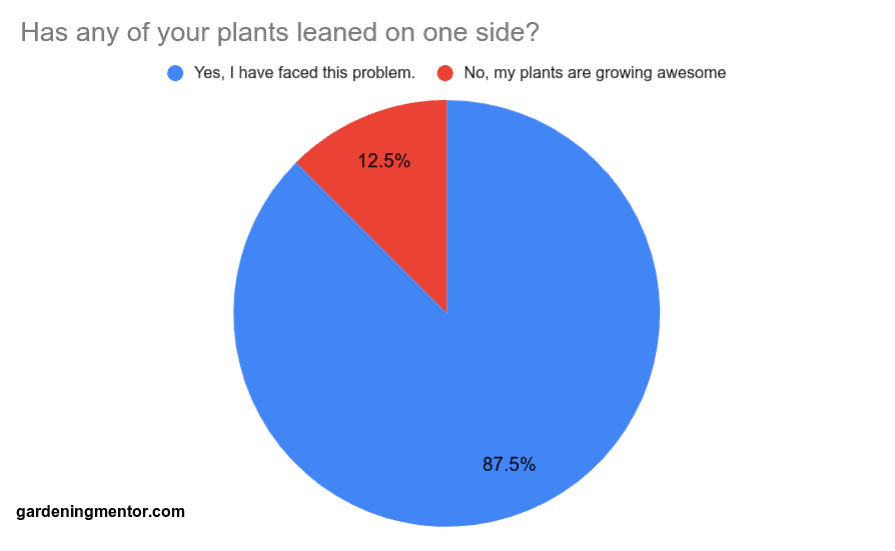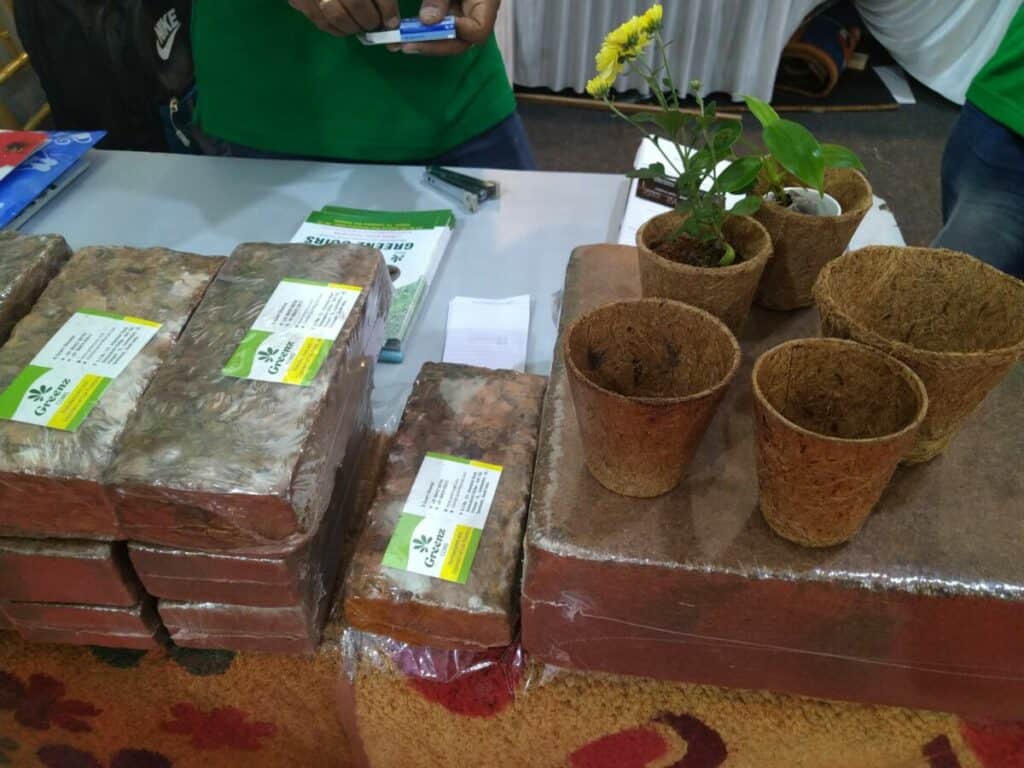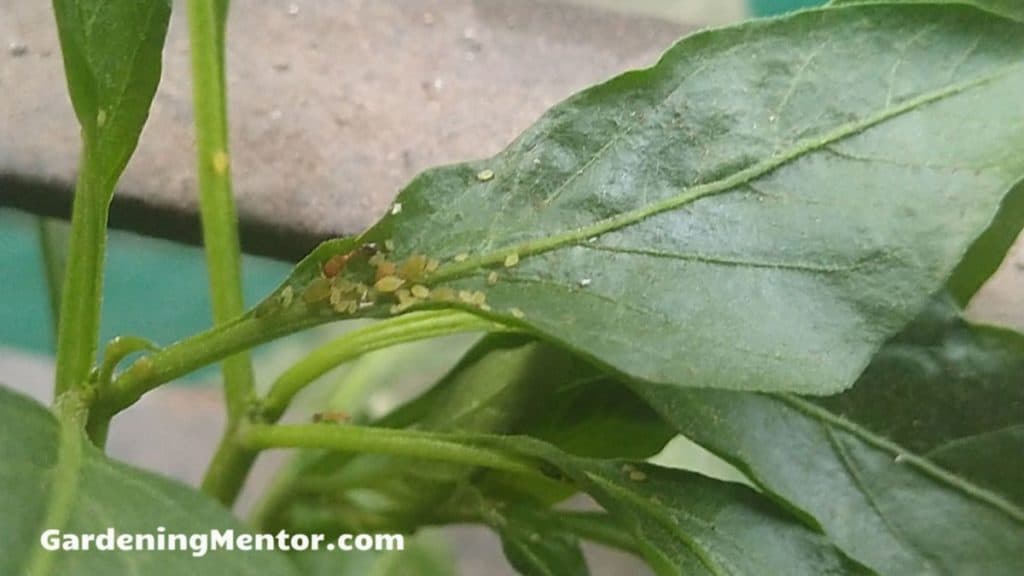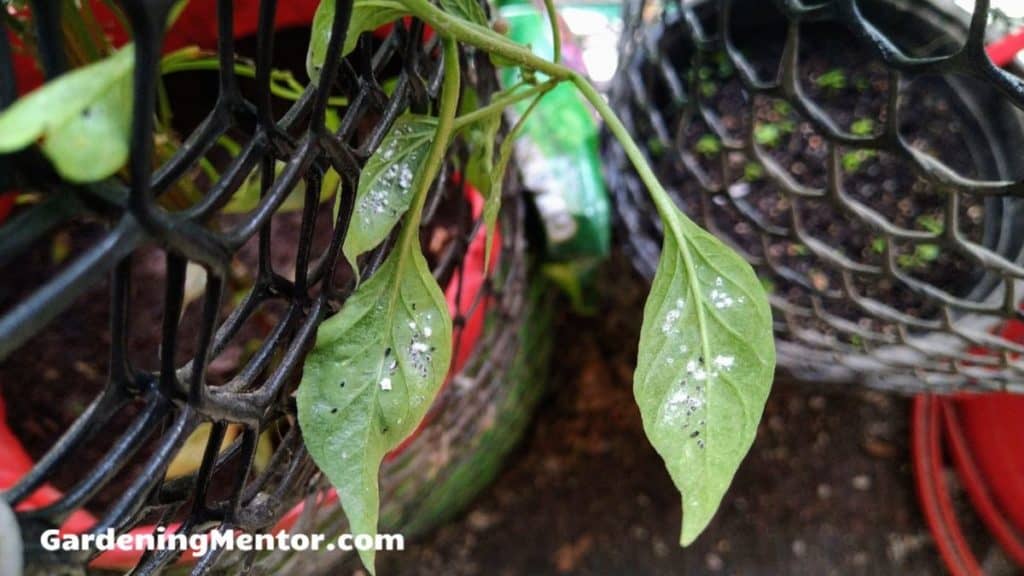It can be frustrating watching your potted plant leaning over. You feel the danger that it might topple over someday.
To fix the leaning potted plant, rotate it every week by 90 degrees. This helps the plant get sunlight on all sides. The main reason a potted plant is leaning because it is receiving sunlight only in one direction. So it’s essential to rotate the houseplants every week.
Once you figure out what’s causing the issue you can take the necessary steps and get it back to growing straight and tall. I’ve written 8 steps that will help you narrow down and fix the problem.
Your potted plant may have become top-heavy causing it to lean. A simple fix is to quickly prune some of the leaves and branches so it regains balance. Check out the best bypass pruners on Amazon.com that can help you with this.
1. Stake the potted plant
The first thing you want to do is protect your potted plant from falling over. It can happen if the plant is leaning dangerously close.
You want to avoid that so I suggest using a stake to prop the plant straight till you fix the underlying issue causing it to lean.
It’s simple to use a stake with a potted plant. You need a long, narrow, and sturdy stick that can hold the plant. Any stick will do such as a bamboo stick, plastic stake, or any wooden stick you can find. It should be several feet tall so it can cover the height of the potted plant.
You need to push the stick deep into the potting soil. Make sure it’s a bit far away from the roots at the center as you don’t want to damage them. Stick it in the opposite direction from the leaning side of the plant.
If it’s a tall plant you could even push this stake into another sturdy pot near the potted plant. If your potted plant is in the garden, you can push the stake in the garden soil itself near the potted plant.
Now straighten the plant so it’s parallel to the stake. Use twine or garden ties to tie the potted plant stem to the stake loosely.
Tie the plant to the stake every 3-4 inches from the bottom to the top so the plant remains straight. You want to tie it loose so that the stake does not harm the stem.
I keep a bunch of different sized stakes in my garage and use as needed: kebab sticks for tiny ones, 2ft stakes, and 5ft stakes. By the end of the season they’re usually all in use in one way or another. – Julie
2. Check if the plant is getting required sunlight
This is the most common issue that will cause your potted plants to lean. You may get growing the plant in a location indoors or outdoors that is getting insufficient sunlight.
The light received on one side of the plant may be more than the other sides. So the plant grows towards the direction of the sunlight causing it to lean.
Observe the sunlight that falls on your plant for the entire day. If you notice that only one portion of the plant is getting the light, you know this is the problem.
This is a simple problem to fix with potted plants. You could move the plant to another location that gets good sunlight on the entire plant.
If you cannot find a better location, you could rotate the plant so all sides can get the required light and grow straight. The best time to do this is when you have to water the plant. You can turn the plant 45 degrees after the watering.
I asked fellow gardeners if they have faced the problem of a leaning plant. 87.5% of them responded that this happens so it’s a very common problem that we need to take care of.

3. Ensure you’re giving the right watering to the plant
Some plants can be sensitive when it comes to watering. Too much water or too little of it can both cause problems.
If you give the plants a lot of water than they need it leads to overwatering. And if you give them too little water you end up underwatering.
These can cause weak growth of the plant’s roots and stem causing the plant to lean or droop.
When you overwater the plant, the roots stand in moist soil for a long time. This humid condition attracts fungal issues like root rot and also causes the roots to drown in moisture.
The roots will become black, soggy, and smell due to the problem. Weak roots cannot supply required nutrients and moisture to the plant which weakens the plant.
The common sign of overwatering is that the leaves are droopy but they appear soft and contain moisture.
When you underwater the plant, it gets less moisture than it needs. This means the roots can’t provide the nutrients to the plant causing it to grow weak.
The lack of moisture deep into the soil prevents the roots from growing deep, further weakening the foundation of the plant.
The sign that you are underwatering the plant is that the leaves will be dry, yellow, and dropping.
You want to make sure the plant is getting the right amount of moisture at the right time. You don’t need fancy equipment to do this.
Stick your finger 1-2 inches into the potting soil to check the moisture. If the soil sticks to your finger it’s the right amount of moisture and you don’t need to water.
Once the soil is dry you need to give a good watering. This means keep watering the potting soil till the water starts dripping from the drainage holes.
4. Prune the potted plant if it’s top-heavy
We love to let our plants grow as much as they want. But if the plant grows large it can become top-heavy causing plant leaning to one side.
Using a stake will help protect the plant in this situation but you want to reduce the stress on the plant. I recommend pruning the potted plant to keep it lighter.
You want to check on the plant every month if it needs pruning. You can trim some leaves, flowers, and branches of the plant as part of this.
The first choice should be leaves, flowers, and branches that are unhealthy. They may have turned yellow or dried out. You can then trim some of the healthier branches to reduce the load on the plant.
Use a clean pair of bypass pruners to trim the plant. You can clean them with rubbing alcohol before the pruning. It helps protect the plant from pests and diseases that could enter the wound. The bypass pruner makes a clean cut that helps the plant recover faster.
I suggest only prune about 1/4th of the plant at one time. If you prune too much, the plant may suffer shock that could cause stress and poor health.
You can cut up the pruned branches and leaves into small pieces and use them in your compost pile or mulch.
5. Avoid using poor quality potting soil
Poor potting soil can cause several issues to the plant that can lead to it leaning and falling over. The potting soil influences overwatering or underwatering of the plant. It also impacts whether your plant has a stable base to grow straight and not lean over.
You want your potting soil to have the right texture. It should be good to retain enough moisture but drain out the excess. But it should not be so soft and porous that it cannot hold the weight of the plant and roots.
If the potting soil contains a lot of clay it will retain water longer which can cause overwatering. If the potting soil contains too much sand it will drain the water fast causing underwatering. We have seen both these situations can cause weak roots and stems causing the plant to lean over.
You need to add the right potting soil before you stake the plant straight. You may even need to re-pot the plant after removing the old potting soil and adding a fresh batch of a good one.
Your potting soil should contain perlite, vermiculite, coco coir or peat moss, and compost in the right balance. 1/4th of each material should be good enough to give it the right texture.
If you find that the potting soil is still soft you can add 1/4th topsoil to it. The topsoil has a more rigid structure and will give stability to the plant and roots.

6. Re-pot the plant if the container is small
It’s great to be able to grow plants in a container when we don’t have space. But it can also be a problem if the plant does not get sufficient growing space.
If the plant outgrows the pot, it will become top-heavy. Another problem is the roots won’t get sufficient growing space and become root-bound. They circle inside the pot and are unable to provide nutrients to the plant.
These problems will cause the plant to start leaning and fall over. I recommend you grow the plant in a pot that is a size larger than it.
As the plant becomes bigger, keep an eye on it. And when it outgrows the pot, move it to a larger one. Some common signs that the plant has become large are if the roots are coming out from the drainage holes. Or the plant is becoming unstable in the pot as it’s top-heavy.
It’s simple to re-pot the plant into a larger container. Hold the plant near the base with one hand. Tilt the pot and gently tap on it until the entire plant comes out.
Keep a larger pot ready with the potting soil added to it. Make a hole large enough to hold the plant and place the roots in it.
Cover the roots with potting soil so they are completely covered and only the base of the plant is above the soil. Give the potting soil a good watering after you have done the re-potting.
7. Protect the plant from environmental stress
Your potted plant can get stressed for several reasons: transplant shock, strong wind, or cold weather. Many of these could lower the health of your plant and cause them to lean.
Transplant shock is a common problem we face when moving transplants or seedlings to their outdoor pots. I recommend hardening the seedlings before moving them out.
The easiest way to do this is to familiarize the plant with the outdoors before. You can keep the seedling outside for a couple of hours every day. Make sure to keep it out of direct sunlight, wind, and rain.
After a week, the plant should be strong enough that you can transplant it to the outdoor pot without problems.
Strong winds can cause your plants to lean and fall over. If the wind is cold it could freeze or even burn the foliage. You want to either bring the plant indoors or use a windshield to protect the potted plant.
Cold weather is another problem that affects the health of the plant. The occasional frost can damage the plant so you need to be prepared. You can move the plant indoors or use a cover.
This could be a cloche, fabric cover, or even a plastic bucket if the plant is small. Make sure the cover does not touch the plant as it will conduct the cold and damage it.
8. Eliminate pests and diseases attacking the plant
If you’re growing plants, they will get attacked by pests and diseases at some point. Sometimes the problem is so bad that the plant becomes weak and can start leaning.
It’s important to know what kind of pest or disease attacks your plant and how to prevent it. So check up on your plant every morning to see if it’s having such issues.

Some insects like aphids, whiteflies, and mealybugs suck sap from the foliage. Insects like cutworms will eat the stem near the base of the plant causing it to lose balance and fall. Some others like snails, and slugs will eat the leaves and stems of the plant.

For small insects you could spray water to knock them off. The larger ones you can pick by hand and put in a bucket of soapy water.
There are also other ways to control pests including using natural remedies. You could use organic materials like neem oil, vinegar, garlic, insecticidal soap, and diatomaceous earth. What you should use depends on the type of pest attacking the plant.
Diseases can range from mildew to more serious ones like Fusarium wilt. There are different methods of treating each type of disease.
You can remove any infected parts of the plant to try and isolate the disease. You should also move the potted plant away from the other plants. This helps reduce the chances of spreading the disease.
You can get rid of fungal diseases by spraying with fungicide solutions. You can buy these products online or find one locally.
Copper spray can treat bacterial diseases by applying copper sprays. Copper has been known to help fight bacterial infections so it can be useful for issues like leaf spots and blights.
If a viral disease infects your plant, there’s not much you can do other than keep pruning the affected parts. The disease will cause the plant to stop growing and die eventually.

Fact Checked, Written, and Published by Kevin Rodrigues
Kevin is the founder of Gardening Mentor, a website that aims to teach people to grow their own food in a limited space. As a self-taught gardener, Kevin has spent several years growing plants and creating gardening content on the website. He is certified in Home Horticulture and Organic Gardening from Oregon State University. He has a Post Graduate Diploma in Horticulture and Landscape Gardening from Mumbai University.
Read more
